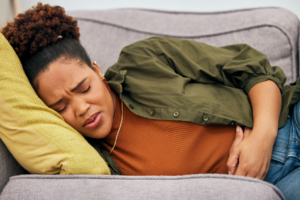Are hysterectomies the only option for fibroids?
Bleeding heavily is a common concern for women of pre- and peri-menopause age. While there can be different reasons for heavy bleeding, a frequent cause are fibroids.
Fibroids (leiomyoma) are benign tumors that grow in the smooth muscle of the uterus. It’s believed that by age 50, 70% of women have fibroids, though most will not know it. About 30% of women with fibroids are symptomatic. Unfortunately, that number disproportionately affects Black women and there is not a good explanation as to why. In general, there is a significant lack of funding for research on fibroids.
Thankfully, fibroids tend to resolve after menopause but they can be quite disruptive while active and growing. Not only can fibroids cause heavy bleeding, which can lead to anemia, they are also associated with pelvic and back pain as well as constipation, increased urination, and abdominal distention due to the pressure these growths put on other pelvic and abdominal organs.
Fibroids can vary in size, ranging from the size of a seed upwards to a melon (yes, women look like they’re pregnant), and number, from a single fibroid to dozens of them at once. Organizations like the White Dress Project share stories of women dealing with fibroids to try to promote awareness as it can sometimes takes years to get proper diagnosis and treatment.
The most common procedure traditionally used to treat fibroids, outside of birth control, has been hysterectomies. In fact, the average age that hysterectomies are performed is early 40s, around the time a woman can enter perimenopause.
Despite its popularity (hysterectomies are the second most common surgery for women, behind C-sections), a hysterectomy is a major operation and despite being able to perform these procedures, gynecologists do not have the same extensive training as surgeons, which can lead to possible complications down the road. In addition, some women are choosing to have children later in life, so removing their uterus is not a desired option. And some women would just prefer to keep their organs, if possible.
Whatever the reason someone decides to keep their uterus, there are some other conventional options as well as some natural ways to help reduce fibroids.
First, there are myomectomies, in which they just remove the fibroids but leave your uterus intact. The type of myomectomy depends on the location of the fibroid. Myomectomies, like hysterectomies, are a surgical procedure which can lead to complications, but is an option to just target the growths and keep your uterus.
Another surgical option is a uterine fibroid embolization. Uterine fibroid embolizations (UFEs) began in the US in the 1990s. They essentially block the blood supply to the fibroid to prevent it from growing. In other words, the fibroids will remain in your uterus, but will not grow any larger than when the UFE is performed. While recovery from UFEs is typically shorter than a hysterectomy or myomectomy, some studies show that almost 10% of women ultimately had a hysterectomy even after a UFE and re-operation was relatively common, affecting about 1 in 5 women. Another study found that almost 25% of women that had a UFE, still had to have additional treatments for fibroids. Although it can be a viable option, there are risks that it will not solve the problem.
The other option is an ablation. This procedure uses heat to shrink the fibroids in size. While ablations effectively treat fibroids and like UFEs, have shorter recovery time, they don’t prevent new fibroids from developing.
While surgery is always a personal option, there is no shame in having surgery if you feel that is best for you. However, none of these conventional options address the root cause of fibroids.
While we don’t know for sure, (an unfortunately all-too-common refrain in women’s medicine) there are some strong theories as to why fibroids develop. As I mentioned earlier, hormone imbalances, such as estrogen dominance, that tends to occur more often during perimenopause, seem to be a common trigger for fibroid growth.
Another compelling theory relates to our increased exposure to endocrine disruptors, products like plastics and other chemicals that can influence our hormones. While these products are ubiquitous, due to genetics and other factors, different women have different abilities to properly metabolize and remove these toxins. Also, it is thought this is a possible reason why Black women are more greatly affected by fibroids as they tend to have a greater exposure to endocrine disrupting chemicals.
Whether you opt for surgery or not, shrinking existing fibroids or preventing them from recurring is important. Bleeding heavily for extended periods of time, pelvic and back pain, and other symptoms from fibroids can greatly disrupt your life.
To start, I recommend testing your hormones to see if there is actually estrogen dominance and figure out the cause. For women with regular cycles, we check estrogen and progesterone about a week before their next predicted cycle. This can tell us whether estrogen is too high relative to progesterone so we have to reduce the formation of estrogen and help the body clear it out of the system.
However, another scenario is if progesterone is too low relative to normal estrogen. This would create the same symptoms of estrogen dominance but our focus would be on ways to raise progesterone and not lowering estrogen. There can be different reasons for estrogen dominance (such as exposure to endocrine disrupting chemicals) so it is important to figure out the underlying cause of estrogen dominance first.
Since the above scenarios call for different treatments, I’ll discuss a few general strategies for fibroids, no matter the cause.
As with most things, we cannot ignore nutrition. Keeping inflammatory foods, like added sugars, to a minimum puts less of a burden on your liver, which is responsible for clearing hormones like estrogen. On that note, coffee and alcohol can have a similar effect so cutting back or ideally, cutting it out for a period of time, can have a great impact on balancing hormones.
We also know meat and animal products, especially if commercially raised, can be inflammatory and worsen estrogen dominance so reducing your intake can have a profound impact. This is actually one of the reasons I became a vegetarian almost 20 years ago due to extremely painful periods likely related to estrogen dominance.
If there is true estrogen dominance, one of my favorite go-tos is diindolylmethane (DIM). DIM helps your body metabolize excess estrogen so it can be removed quickly. DIM is a natural compound found in cruciferous veggies like broccoli and cauliflower. We typically use it in a supplement form as it is in a more concentrated amount.
One of my other favorite treatments for estrogen dominance are castor oil packs over the liver. Since estrogen is cleared through the liver, castor oil packs help reduce any inflammation in the liver so it essentially can do its job better. Castor oil packs are simple and easy to use as all you need is an old cotton cloth or T-shirt, castor oil, and a heating pad.
When it comes to estrogen dominance due to low progesterone, just like estrogen, there can be different causes. One common cause of low progesterone is high stress.
Progesterone can ultimately be converted to cortisol, one of our stress hormones. If cortisol is elevated due to stress, that “steals” progesterone away and can lead to low progesterone. If that is the case, the appropriate treatment is to work on dealing with the stress.
There are other reasons progesterone can be low, mainly due to lack of ovulation. When we ovulate, the ovaries produce ample amounts of progesterone. On the other hand, if we don’t ovulate due to things like perimenopause or PCOS, then we will have low progesterone. Figuring out the cause of the low progesterone is crucial for deciding on the correct course of action.
Whatever the cause, there are so many options for treating fibroids, whether natural or conventional or even a combination of both. For example, I know many women who have done well with getting an ablation to stop the heavy bleeding but then use natural means to help prevent new fibroids from growing. There is no right or wrong when it comes to deciding what’s best for your body.
References
https://emedicine.medscape.com/article/421734-overview
https://www.ncbi.nlm.nih.gov/pmc/articles/PMC8432600/#B63
https://www.ncbi.nlm.nih.gov/pmc/articles/PMC8290307/
 Previous Post
Previous Post Next Post
Next Post

